With verdant landscapes, beautiful bridges, and gently flowing streams, the University of Macau (UM) provides an ideal environment for academic pursuits. More than just a physical space, the UM campus is a dynamic canvas that reflects the vibrant lives, meaningful interactions, and rich experiences of its members. Designs across the campus not only enhance its aesthetic appeal, but also encapsulate the memories and legacies of UM alumni that resonate with the university community.
Impressions of UM
The UM campus features many iconic scenes, from the bustling ‘Hi-Bye’ bridge, an essential route for students heading to their classrooms, to the faculty buildings where students diligently pursue knowledge, and the UM Library, where they immerse themselves in their studies late into the night. These landscapes have inspired numerous artists, including renowned Macao artists Lio Man Cheong, Pun Kam Ha, and Cai Guo Jie, who are drawn to UM to capture its beauty through their artistic talents. Some UM alumni have also created artwork depicting the campus as a tribute to their alma mater. More than just paintings, these artistic creations have inspired UM souvenirs, allowing faculty, students, and visitors to take home a piece of the campus’s beauty.
The UM bookmark series created by Yang Sio Maan, an alumna of the Department of English and a Macao illustrator, is one such example. After graduation, Yang pursued a career in the arts. Some of her achievements include claiming the New Talent Category Winner title (Advertising) at the World Illustration Awards by the Association of Illustrators in 2019, and exhibiting a painting depicting life on the UM campus in London the same year. In 2020, Yang designed a series of bookmarks for the university under the theme ‘A Day at UM’. The bookmarks, which were popular among faculty, students, and the public, featured her illustrations capturing various snapshots of university life. When sharing her design ideas, Yang says, ‘Those days at university always hold a special place in my heart.’
Yang’s bookmarks effectively denoted the daily activities of UM members: hurried walks along the Alumni Avenue, learning sessions in faculty buildings, relaxing moments by the lake, leisurely strolls in corridors, chats with peers in residential colleges, and focused hours in the library. To add vibrancy to these everyday scenes, Yang included some special elements in her illustrations. ‘Small animals like kittens and turtles are common sights on campus, so I deliberately included them in my work. They are like our friends on campus,’ she explains.
The paintings of UM landscapes, whether created by renowned artists or UM alumni, vividly convey their impressions of and emotional connections to the university. Yang shares, ‘I hope that when people see the bookmarks, they resonate with them and feel a sense of familiarity. The illustrations represent not only my experiences and those of my friends at UM, but also the everyday life of every UM student.’
A loving message
From a macro perspective, design serves as a vessel for conveying spirit, as demonstrated by the symbolic meanings found in national flags, national emblems, regional flags, and regional emblems. Located in the west zone of the UM campus is a cluster of ten residential college buildings distinguished by their orange exteriors. Unique emblems are prominently displayed in these residential college lobbies. Each emblem is designed to embody the educational philosophy of its respective college and to reflect the distinctive characteristics of the community and peer education provided by the college.
UM’s residential colleges are also home to many interesting and creative designs, many of which are created by students. The logo of the volunteer teaching team of Chao Kuang Piu College (CKPC) is one example. ‘The logo features an owl and a book. The owl, a symbol of wisdom, represents members of the volunteer teaching team, while the book symbolises the sharing of knowledge,’ explains Cheang Si Man, the logo’s designer. As a former leader of the CKPC volunteer teaching team and an alumna of the Faculty of Education, Cheang emphasises, ‘This design serves as a reminder for members to put their knowledge into practice by supporting teachers in mountainous areas in China and developing a passion for learning among the students there.’
‘The design of the logo of the CKPC volunteer teaching team carries a loving message,’ says Kun Weng Meng, the current leader of the teaching team and a second-year student in the Department of Psychology. As Kun discusses the logo, she holds up her teaching team name badge, which features the logo alongside her name. ‘This badge symbolises a sense of belonging. During the design process, we intentionally left some space next to each member’s name. Each time you participate in a volunteer teaching service, you can place a star sticker in that space. Our college master Lau Yun-Tung has the most stars because he has joined us for every volunteer teaching service since the programme started.’
Kun adds, ‘Of course, while the star stickers are nice, what truly matters is the teaching experience we gain from each volunteer teaching service. These experiences have deepened our understanding of the educational needs of the children of migrant workers. The time spent with them is equally precious.’
Have you ever met Uncle Charlie?
Designs that symbolise multiculturalism are prominent at UM academic activities and workshops. As a platform for knowledge dissemination and innovation, the university is committed to fostering an academic environment that embraces multicultural integration and encourages faculty and students to learn about the history and culture of different countries. In view of this, when organising international academic events and designing promotional materials, UM faculties focus not only on the event’s theme, but also the integration of the university’s multicultural academic culture.
In the Faculty of Arts and Humanities (FAH) lives ‘Uncle Charlie’, the knowledgeable mascot who serves as the faculty’s ‘Goodwill Ambassador’ and symbolises multiculturalism. A fixture on every special event at FAH, Uncle Charlie’s adorable appearance always creates excitement. Uncle Charlie is a particular attraction at the UM Open Day, and both adults and children eagerly line up to take photos with him. In addition, he participates in the UM Language and Culture Day as a special guest for the ribbon-cutting ceremony. Uncle Charlie also enhances audience experience by engaging with members and joining them in appreciating the cultural performances of faculty and students.
There is a fascinating story behind the design of this mascot. Uncle Charlie sports a stylish top hat that adds an artistic touch to his look, along with a UM badge on his chest and a shoulder sash adorned with badges from various countries. As a linguist with a passion for the arts and humanities, Uncle Charlie is always on a cultural journey, seeking to explore and understand the rich tapestry of cultures around the world.
‘Uncle Charlie embodies optimism and positivity. He promotes the value of multiculturalism at every cultural event at the university,’ says Li Defeng, associate dean of FAH. ‘In the era of artificial intelligence, it has become more important to emphasise the power of the humanities and showcase the enduring appeal of language and culture. In FAH, Uncle Charlie is like a friend who is always with us. He reminds people to transcend cultural boundaries and explore and appreciate the beauty of diverse cultures.’
Future aspirations
Some UM designs embody future aspirations. One such example is the university emblem, which incorporates not only the name of the university, but also a bridge that symbolises UM’s role in connecting Eastern and Western cultures. In addition, the key in the emblem represents the gateway to knowledge. The UM motto, which lists five virtues¬—Humanity, Integrity, Propriety, Wisdom, and Sincerity— further enriches its symbolism. Another notable example is the sculpture ‘The Wall of Great Wisdom’ located in the UM Lotus Square. This piece, a gift from the Chinese Ministry of Education, reflects the ministry’s hopes that the university will nurture talent who possess wisdom, elegance, and a dedication to promoting traditional Chinese culture.
Recently, three text-based installations featuring ‘University of Macau’ have been set up in the UM Library plaza, by the lakeside near the roundabout in the north zone, and on the lawn near the UM stone sign, respectively, quickly becoming popular photo spots on campus. Designed and produced by the Communications Office (CO), these installations represent some of the university’s latest creative efforts. In two of these installations, books are positioned beneath the word ‘University’, symbolising UM as a temple of knowledge and encouraging faculty and students to boldly pursue their academic endeavours.
‘By designing various promotional materials for UM, we aim to communicate the university’s message to faculty, students, and visitors from around the world,’ says Katrina Cheong , director of CO. She adds that as long as the design is accessible to UM members or campus visitors—whether it is a lamppost banner, a roadside poster, or a TV display—it reflects the educational philosophy of the university.
Dr Cheong uses the lamppost banners as an example, explaining, ‘UM members often come across the lamppost banners on campus. Over time, the repeated exposure to these banners, which reflect the university’s culture and spirit, fosters a sense of belonging and connection among faculty and students. For first-time visitors to UM, their first impression of the university is especially important. Therefore, the designs at a university are not just aesthetic elements; they also communicate its educational philosophy and vision.’
Subtle but long-lasting influence
Every thoughtful design embodies a value that resonates with its audience. As one walks around the UM campus, these designs function as symbols of the university culture. They not only reflect the aspirations of UM students, but also accompany those students on their academic journeys, exerting subtle but long-lasting influence.
Text: Kelvin U
English translation: Bess Che
Photos: Editorial Board, with some provided by the interviewees
Source: My UM Issue 135
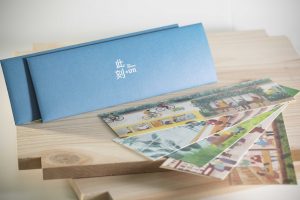
The ‘A Day at UM’ bookmark series
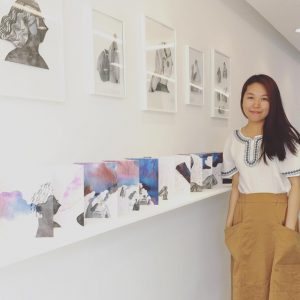
Yang Sio Maan
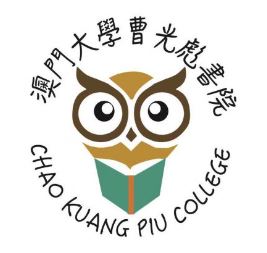
CKPC volunteer teaching team

Cheang Si Man

Kun Weng Meng and her students
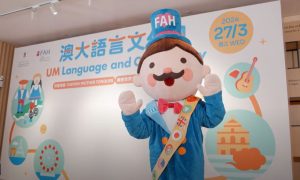
Uncle Charlie participates in the UM Language and Culture Day as a special guest
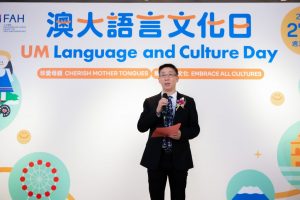
Prof Li Defeng
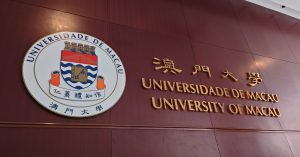
UM emblem
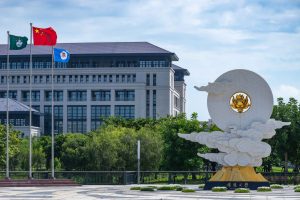
‘The Wall of Great Wisdom’ located in the UM Lotus Square
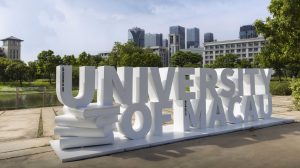
The text-based installation featuring ‘University of Macau’ by the lakeside
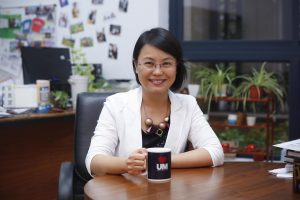
Dr Katrina Cheong
